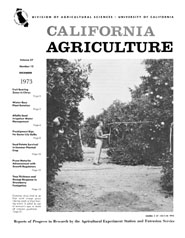


University of California
California Agriculture
|
|||
|
|||

Cover:
Counting citrus fruit in an Ojai navel orange grove (during study of fruit bearing
zones) is aided by use of surveyor’s tape to mark off compass quadrants.
December 1973
Volume 27, Number 12 News and opinion |
|||
|
University of California, 1301 S. 46th St., Bldg. 478 Richmond, CA
|